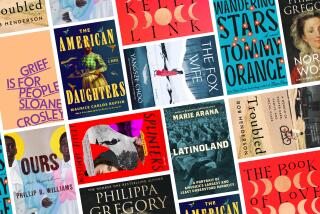Q&A: Sloane Crosley reveals the literary bad man who inspired her first novel
- Share via
Sloane Crosley is known for her essay collections “How Did You Get This Number?” and “I Was Told There’d Be Cake,” lauded for their wit and irreverence. The same qualities characterize her debut novel, “The Clasp” (Farrar, Straus and Giroux, 384 pp., $26). It follows three college friends: Victor, who works at a search-engine start-up; Kezia, who works at a jewelry boutique; and Nathaniel, who might not even work.
When Victor hears a story about how Guy de Maupassant’s famous short story “The Necklace” was inspired by an actual real-life object, he asks Kezia, the friend he’s been pining for since college, for advice, but she brushes him off. So he decides to solve the mystery himself. Worrying over Victor, in turn, pushes Kezia to Paris — and Nathaniel. “The Clasp” takes us around the world, following the characters through Los Angeles, New York and France, and back in time with stories of World War II, Maupassant’s life in France, and the characters’ own college years.
Crosley, who lives in Brooklyn, spoke to us over the phone about the oddness of college friendships, stories about other stories, and why she knows so much about jewelry clasps.
Why did you pick “The Necklace”?
Well, it’s not my favorite short story in the world. Which is an understandable assumption, I guess, if one writes a 400-page novel based on a short story, you should like it. I was more thinking, it started out as just the voices of these three people who developed in their own time and their own order. I was thinking, they’re at that time period where you think, “OK, there’s one more group excursion from college. If I don’t go on it are we pretty much done here? Am I still part of this group of friends? I’m going to call this person one more time, and then if I don’t hear back, OK.”
That is more of an observation, and it needed a pulse and a structure to it. I’ve always been fascinated by books that are somehow about another art form. “The Moon and Sixpence” would be a good example, life of Gauguin. “On Beauty,” with Zadie Smith on E.M. Forster....
Then I started discovering more about Guy de Maupassant, who was a total character. Also, by the way, not a great guy. He really did have a parrot that greeted female visitors with, “Hello, my little whore.” I just like the idea of him being this paragon of manhood for one of my main characters, Victor, who feels like such a wet noodle for half the narrative.
How were you able to get so detailed when it came to jewelry? The particular clasp in the title, I definitely had a necklace like that and it definitely came off all the time.
Really? I’m sorry about your loss, sorry about the necklace, but that makes me very happy. Part of it is I went to a public high school. Somehow, I don’t know why, we had a jewelry department. It was in the art department, we used to take jewelry classes. Weirdly I didn’t have amazing courses in math, I had to have outside tutoring for the SATs and all of it, but I’ve known what a cabochon is since I was about 14.
It’s funny what seems obvious and what doesn’t. I remember talking to my editor at some point. She was like, “A lobster clasp?”
How do you think writing nonfiction contributed to how you write fiction?
In a way, when you’re writing fiction and nonfiction, but especially narrative nonfiction, you’re not going to have tons and tons and tons of dialogue because the point of an essay is the larger point you’re trying to make. You can’t just have other people speak for you in dialogue.
The thing is, if I wanted to make this novel 1,000 pages quickly, I could just have them keep talking. You set these people up. You allege that they’re real. Just have to them keep talking.
Misra is a freelance writer who lives in Los Angeles.
More to Read
Sign up for our Book Club newsletter
Get the latest news, events and more from the Los Angeles Times Book Club, and help us get L.A. reading and talking.
You may occasionally receive promotional content from the Los Angeles Times.






